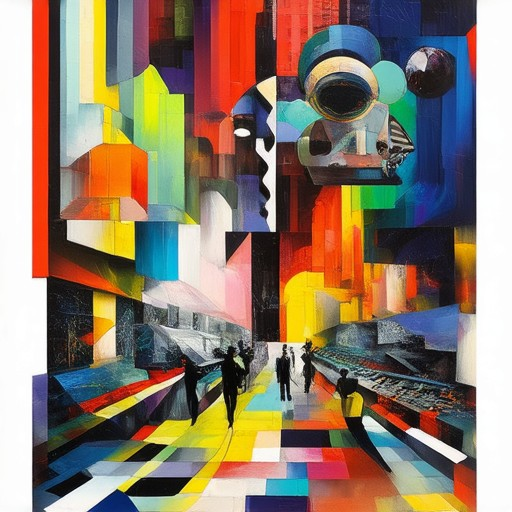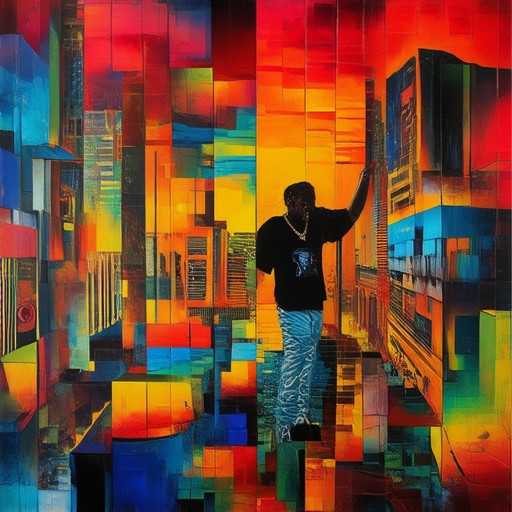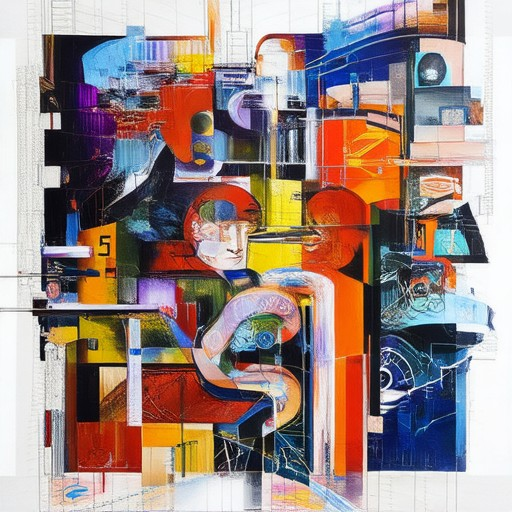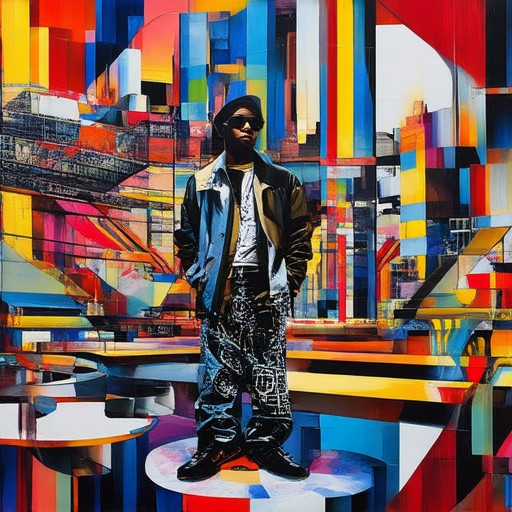Avant-garde rap culture represents a groundbreaking movement in music that challenges traditional norms while pushing boundaries of creativity and expression. Rooted in the rich tapestry of Black cultural heritage, this genre has emerged as a powerful force, blending intellectualism with raw emotion to craft unique sounds and narratives. From its inception, avant-garde rap has been a platform for artists to explore uncharted territories, experimenting with unconventional styles and themes that resonate deeply with audiences.
Key Takeaways
– Golden Age of Hip-Hop: The late 1980s and early 1990s marked hip-hop’s golden era, characterized by artistic excellence, cultural impact, and iconic albums by legends like Nas, Tupac Shakur, and The Notorious B.I.G.
– Influence on Black Culture: Hip-hop is an integral part of Black culture, serving as a medium for storytelling, social commentary, and preserving African heritage while influencing global trends.
– Technological Innovation: The rise of digital tools and streaming platforms revolutionized hip-hop production and expanded its global reach.
– Global Phenomenon: From its origins in the Bronx, hip-hop transcended borders, becoming a universal language of youth and rebellion.
– Iconic Artists and Legacy: The genre’s legacy lies in its ability to inspire new generations, with artists like Snoop Dogg and Kendrick Lamar continuing its evolution.

What is Avant-Garde Culture?
Avant-garde culture refers to a style of innovation and experimentation in various fields, including art, music, fashion, and design. It represents a movement that challenges traditional norms and explores new ideas, often pushing boundaries to create something groundbreaking. The term “avant-garde” originated in the late 19th century, primarily associated with artistic movements like Cubism and Futurism, but it has evolved to encompass a wide range of creative endeavors.
Key Characteristics of Avant-Garde Culture
- Innovation : Avant-garde culture thrives on innovation, constantly seeking new ways to express ideas and challenge conventions.
- Experimentation : It involves experimenting with new techniques, materials, and perspectives to create unique works.
- Originality : Avant-garde artists and creators often produce work that is distinctly original, reflecting a unique vision or perspective.
- Progressive Ideas : Many avant-garde movements are tied to progressive social, political, or philosophical ideas, aiming to drive change and inspire reflection.
Historical Context
The concept of avant-garde began to take shape in the 19th century with figures like Eugène Delacroix and Frédéric Chopin, who broke away from established traditions to explore new artistic territories. By the early 20th century, movements like Cubism, Dada, and Surrealism became synonymous with avant-garde culture, each bringing its own unique flavor and influence.
Impact Across Art Forms
Avant-garde culture has left a lasting mark across various art forms:- Visual Arts : Movements like Cubism and Abstract Expressionism redefined painting and sculpture.- Music : Jazz and experimental music pushed boundaries, embracing improvisation and unconventional instruments.- Fashion : Designers like Yves Saint Laurent and Jean Paul Gaultier introduced bold, avant-garde styles that challenged traditional norms.- Literature : Figures like James Joyce and William S. Burroughs experimented with narrative structures and language to create groundbreaking works.
Avant-Garde Today
Today, avant-garde culture continues to evolve, influencing everything from digital media to contemporary fashion. Platforms like Abstract Hip Hop exemplify how avant-garde ideals can thrive in modern contexts, blending experimental sounds and innovative storytelling.
At Abstract Hip Hop , we celebrate the spirit of avant-garde culture by exploring the intersection of music, art, and culture. Our platform dives deep into the unconventional sounds and creative processes behind abstract and experimental hip-hop, offering readers a window into the future of music and art.
What is Avant-Garde Music Theory?
Avant-garde music theory is a conceptual framework used to understand and analyze music that challenges traditional harmonic, melodic, and rhythmic structures. This theory often explores innovative sound design, non-traditional composition techniques, and experimental approaches to music-making.
Characteristics of Avant-Garde Music Theory
- Innovation : Avant-garde music theory emphasizes the creation of new sounds and styles that push beyond conventional boundaries.
- Critique of Tradition : It often critiques established musical norms, seeking to disrupt expectations and provoke thought.
- Exploration of Sound : Composers and musicians frequently experiment with unusual timbres, textures, and harmonies.
- Non-Functional Harmony : Traditional harmony often serves a functional purpose, but avant-garde theory prioritizes exploration over functionality.
- Polystylism : Combining disparate styles and musical languages is common in avant-garde works.
Historical Context
Avant-garde music theory has evolved alongside significant movements in music history:- Serialism : A 20th-century movement focused on organizing music through fixed sequences of pitches and rhythms.- Minimalism : Characterized by simple, repetitive melodies and harmonies, often using few notes or chords.- Aleatoric Music : Involves chance operations, where compositional decisions are left to chance during performance.
Key Figures and Works
- Pierre Boulez : Known for his serialist compositions, including Pierre Boulez: Anthology of His Works .
- Karlheinz Stockhausen : Pioneered microtonal music and explored aleatory techniques.
- John Cage : Influential figure in experimental music, known for Silence and Music for Piano No. 4 .
- Steve Reich : A minimalist composer whose works blend traditional and contemporary elements.
Techniques in Avant-Garde Composition
- Extended Techniques : Musicians use extended instrumental techniques, such as quarter tones, glissandos, and multiphonics.
- Microtonality : Working beyond the standard 12-tone scale, composers explore intervals smaller than a semitone.
- Text in Music : Incorporating verbal elements or texts into musical compositions.
- Improvisation : Many avant-garde pieces allow for improvisation, encouraging spontaneity and collaboration.
Challenges and Controversy
Avant-garde music theory often faces criticism for its difficulty in performance and its perceived lack of emotional engagement. Performers face challenges in executing complex notation and maintaining audience interest.
Resources and Platforms
For further exploration, visit platforms like:- Bandcamp – Discogs – YouTube
These platforms offer a wealth of avant-garde music and related content, connecting artists and fans worldwide.

The Four Cultures of Hip-Hop
Hip-hop culture is a vibrant and multifaceted phenomenon that encompasses various artistic expressions and social movements. While it is often broken down into its core elements, hip-hop can also be viewed through the lens of distinct cultural subsets. Below are the four primary cultures that define hip-hop:
1. DJ Culture
- At the heart of hip-hop lies the DJ, whose role as a turntable operator and scratcher has been instrumental in shaping the genre’s sound.
- DJs manipulate records, using techniques like beatmatching and scratching to create rhythmic patterns and loops.
- The DJ culture is deeply rooted in African American communities, with figures like Afrika Bambaataa and DJ Kool Herc being foundational figures.
- Learn more about DJ culture .
2. Rap Culture
- Rap is the lyrical component of hip-hop, where MCs (Master of Ceremonies) deliver rhymes and stories over beats.
- Rap culture emphasizes storytelling, social commentary, and personal expression, making it a powerful tool for addressing issues and spreading knowledge.
- The art of rhyming has evolved over time, with modern rap incorporating diverse styles from conscious hip-hop to commercial trap.
- Explore rap culture .
3. Graffiti Culture
- Graffiti, or “writing,” is the visual art form that has long been associated with hip-hop.
- Artists like Jean-Michel Basquiat and Futura 2000 have blended street art with hip-hop aesthetics, creating works that resonate culturally.
- Graffiti has historically been a means of expression and rebellion, often used to assert identity and challenge societal norms.
- Discover graffiti culture .
4. Breakdance Culture
- Breakdance, or “B-boying,” refers to the physical aspect of hip-hop, characterized by intricate moves and routines performed to music.
- Groups like the Rock Steady Crew and the Lockers have popularized this form of dance, turning it into a global phenomenon.
- Breakdance culture is not just about individual skill but also about teamwork, creativity, and the shared joy of movement.
- Dive into breakdance culture .
These four cultures—DJ, Rap, Graffiti, and Breakdance—form the foundation of hip-hop, each contributing uniquely to its identity and evolution. From the rhythmic beats of the DJ to the lyrical prowess of rappers, and from the visual art of graffiti to the dynamic movements of breakdancers, hip-hop continues to inspire and unite people worldwide.

What is Considered the Golden Age of Hip-Hop?
The golden age of hip-hop is widely regarded as the period between the late 1980s and early 1990s, marked by exceptional creativity, lyrical depth, and cultural impact.
- Artistic Excellence: This era saw the rise of legendary artists who blended storytelling, complex flows, and socially conscious lyrics. Names like Nas, Tupac Shakur, The Notorious B.I.G., and Jay-Z redefined the genre with their innovative approaches and emotional resonance.
- Cultural Impact: Hip-hop began to transcend its roots in African-American communities, gaining mainstream popularity and influencing global culture. This period solidified rap as a powerful form of self-expression and social commentary.
- Raw Authenticity: Beats were raw and organic, often produced with minimal equipment, giving the music a gritty, unpolished charm that resonated deeply with audiences.
- Albums as Classics: Iconic releases like Nas’s Illmatic , Tupac’s Me Against the World , and The Notorious B.I.G.’s Ready to Die continue to be celebrated as masterpieces, showcasing the genre’s evolution and artistic breadth.
- Rap Battles and Community: The era popularized rap battles and fostered a sense of camaraderie among artists, despite intense competition. This collaborative spirit helped shape the culture around hip-hop.
The golden age laid the foundation for modern hip-hop, influencing countless artists and fans. Its emphasis on authenticity, storytelling, and social commentary continues to inspire new generations of musicians and fans worldwide.
When Was Rap at Its Peak?
Rap reached its peak during the 1980s and 1990s, marked by groundbreaking artists and cultural shifts. This era saw the rise of East Coast and West Coast hip-hop movements, blending social commentary with catchy hooks and rhythmic beats.
The Golden Era of East Coast Rap
- The 1980s: Artists like Grandmaster Flash and Royce Da 5th Floor pioneered rap with tracks like “Rhythm to the Beat” and “Planet Rock.”
- The 1990s: Groups like PUBLIC ENEMY and NAS dominated the scene with socially conscious lyrics and raw delivery.
The Rise of West Coast Rap
- Los Angeles became a hub for gangsta rap in the late 1980s and 1990s, with artists like Snoop Dogg and Tupac Shakur redefining the genre.
- Labels like Death Row Records and Interscope Records propelled West Coast rap to mainstream success.
Technological Impact
- Digital audio workstations and sampling technology in the 2000s revolutionized rap production, allowing for more creative and layered sounds.
- Streaming platforms and mixtape culture further expanded rap’s global reach, making it accessible to audiences worldwide.
Rap’s peak wasn’t just about music—it was a cultural movement. From storytelling to social commentary, rap became a mirror reflecting society’s struggles and triumphs. Today, its influence continues to shape music and culture globally.

Is Hip-Hop Part of Black Culture?
Yes, hip-hop is an integral and inseparable part of Black culture. Originating in the late 1960s and early 1970s in the Bronx, New York City, hip-hop emerged as a cultural phenomenon rooted in African American experiences. It has since evolved into a global movement, but its foundation remains deeply connected to the Black community.
At its core, hip-hop reflects the struggles, triumphs, and perspectives of African Americans. It serves as a medium for storytelling, social commentary, and artistic expression, often addressing issues such as systemic racism, economic inequality, and urban life. The genre’s beats, rhymes, and lyrical content are heavily influenced by African rhythms, blues, and jazz, creating a bridge between traditional Black musical traditions and modern urban sounds.
The Roots of Hip-Hop
Hip-hop’s origins can be traced back to block parties in the South Bronx, where DJs like DJ Kool Herc innovated the genre by extending breaks and adding MCs to rhyme over the beats. This led to the development of rap music, which became a central component of hip-hop culture. Over time, the genre expanded to include various subgenres like East Coast rap, West Coast hip-hop, Southern hip-hop, and more, each with its own unique style and cultural influences.
Influence on Black Culture
Hip-hop has had a profound impact on Black culture, shaping its identity and reinforcing cultural pride. It has provided a platform for Black artists to tell their stories, challenge societal norms, and celebrate their heritage. The genre has also influenced fashion, language, and social movements, making it a powerful tool for cultural preservation and empowerment.
Global Impact
While hip-hop originated in the United States, it has become a global phenomenon, with influence spanning every continent. Black culture has played a pivotal role in shaping hip-hop’s evolution, and hip-hop, in turn, has helped spread Black cultural practices and values worldwide. Artists from around the world have embraced hip-hop as a means of self-expression, further cementing its place as a universal language of youth and rebellion.
Preservation of Black Culture
One of hip-hop’s most significant roles in Black culture is its role in preserving and celebrating African heritage. Through lyrics, beats, and visuals, hip-hop continues to honor African traditions, histories, and contributions. It has also served as a catalyst for social change, inspiring activism and fostering a sense of unity among Black communities.
Conclusion
Hip-hop is not just music; it is a cultural movement, a reflection of Black resilience, creativity, and identity. From its humble beginnings in the streets of the Bronx to its global dominance today, hip-hop has remained a vital part of Black culture, shaping lives and influencing generations.





0 Comments